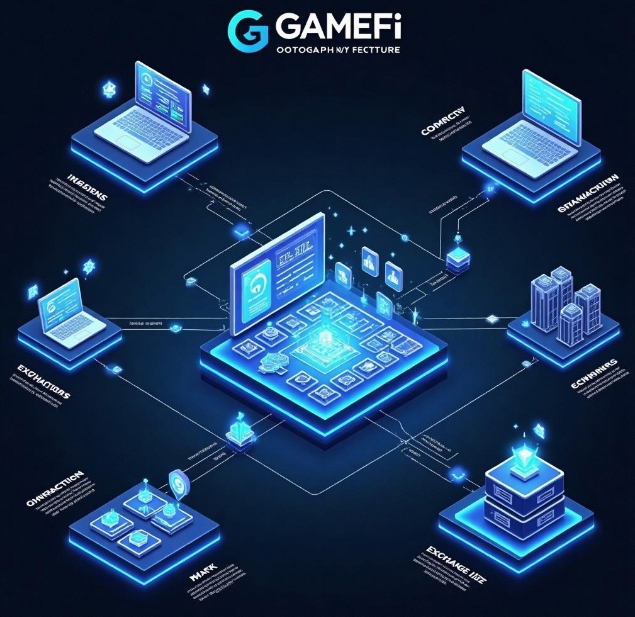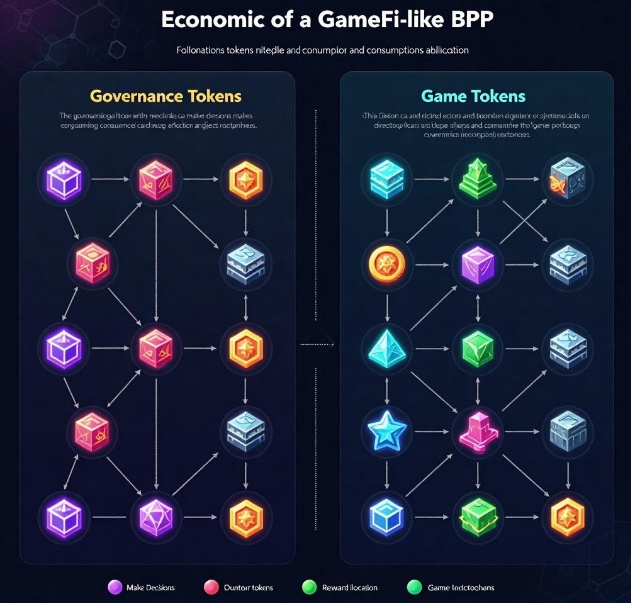Logical Framework and Economic System for GameFi DApp Development
- latest articles
- 1.DApp Development & Customization: Merging Diverse Market Needs with User Experience 2.Analysis of the Core Technical System in DApp Project Development 3.How to achieve cross-chain interoperability in Web3 projects? 4.How does the tokenization of points reconstruct the e-commerce ecosystem? 5.How to Set and Track Data Metrics for a Points Mall? 6.What is DApp Development? Core Concepts and Technical Analysis 7.Inventory of commonly used Web3 development tools and usage tips 8.Development of a Distribution System Integrated with Social E-commerce 9.Six Key Steps for Businesses to Build a Points Mall System 10.What is DApp Development? A Comprehensive Guide from Concept to Implementation
- Popular Articles
- 1.Future Trends and Technology Predictions for APP Development in 2025 2.Analysis of the DeFi Ecosystem: How Developers Can Participate in Decentralized Finance Innovation 3.From Zero to One: How PI Mall Revolutionizes the Traditional E-commerce Model 4.DAPP Development | Best Practices for Professional Customization and Rapid Launch 5.Recommended by the Web3 developer community: the most noteworthy forums and resources 6.From Cloud Computing to Computing Power Leasing: Building a Flexible and Scalable Computing Resource Platform 7.How to Develop a Successful Douyin Mini Program: Technical Architecture and Best Practices 8.Shared Bike System APP: The Convenient Choice in the Era of Smart Travel 9.How to Create a Successful Dating App: From Needs Analysis to User Experience Design 10.From Design to Development: The Complete Process of Bringing an APP Idea to Life
In recent years, GameFi (Game + Finance), as a significant outcome of the integration of blockchain technology and the gaming industry, has rapidly emerged and formed a unique market ecosystem. GameFi DApps (Decentralized Applications) break away from the traditional gaming industry's "entertainment-centric" business model, shifting towards a dual incentive system guided by "Play-to-Earn," providing users with a dual experience of gaming entertainment and asset appreciation. This article will systematically analyze the construction approach of GameFi DApps from two dimensions: the development logic framework and the economic system.
I. Development Logic Framework of GameFi DApps
The development of GameFi DApps differs from ordinary Web2 gaming projects, as their design logic is more complex, requiring both game playability and the construction of a sustainable economic system. Therefore, their logical architecture can be roughly divided into the following five layers:
1. Game Mechanics Layer
This is the foundational logic base of the entire GameFi DApp, including game rules, gameplay logic, player progression paths, asset acquisition methods, and task systems. It not only determines the fun and stickiness of the game but also directly influences player behavior and asset flow.
For example, the following mechanisms can be set in the game:
Task and Challenge System: Daily tasks, main storyline, dungeon challenges, etc., to encourage user activity.
Level and Attribute Growth: Enhance character attributes through combat, mining, or other methods.
NFT Asset Application: Game characters, equipment, land, etc., are represented as NFTs, possessing uniqueness and scarcity.
2. Blockchain Interaction Layer
This layer handles all parts involving on-chain data, mainly including:
NFT Minting and Trading (ERC-721 / ERC-1155 Standards)
Game Token Issuance and Management (ERC-20)
User Wallet Connection and Signature Interaction (Supporting Metamask, WalletConnect, etc.)
Smart Contract Deployment and Security Assurance
This layer determines the asset ownership mechanism and its tradability, serving as the technical guarantee for GameFi to achieve "assets on-chain."
3. Economic System Layer (Tokenomics)
This is key to the sustainable operation of GameFi DApps, requiring a design that balances deflation and inflation, production and consumption, incentives and governance.
Economic system design typically includes two main tokens:
Governance Token: Used for voting governance and long-term value bearing.
Utility Token: Used for daily transactions, reward distribution, NFT upgrades, etc.
A good economic model needs to establish a healthy "production-consumption-destruction" cycle mechanism to avoid hyperinflation.
4. Backend Services Layer
Although GameFi emphasizes decentralization, a certain degree of centralized services is still needed to support game operations, such as:
Data Caching and User Behavior Analysis
Matching Mechanisms, Leaderboards, and Other Off-Chain Logic
Security Monitoring and Anti-Cheating Systems
These backend services should efficiently collaborate with on-chain modules through off-chain methods (such as IPFS, The Graph, Moralis, etc.).
5. Frontend Interaction Layer (Frontend/UI)
The user experience of the game ultimately lands on the frontend, involving UI/UX design, 3D rendering, animation interaction, Web3 wallet integration, etc. To ensure a good experience, a clear asset management interface, intuitive transaction paths, and smooth interaction logic should be provided.
II. Detailed Explanation of GameFi Economic System Design
A sustainable GameFi project must have a sophisticated, balanced, and dynamically adjustable economic system. Its key elements include:
1. Token Design
Most GameFi projects adopt a "dual-token model" to prevent the price volatility of one token from affecting the entire ecosystem.
Utility Token (Game Currency): High circulation, unlimited issuance, but requires strict consumption mechanism design.
Governance Token (Governance Coin): Limited issuance, high scarcity, used for holder governance voting, dividends, etc.
Additionally, bound tokens (such as sToken, vToken, etc.) can be introduced for staking, time-locking, etc., to enhance user stickiness.
2. NFT Economy
As core assets, the value of NFTs is determined by factors such as scarcity, functionality, and upgradability.
Scarcity Design: Different levels of NFTs have different issuance quantities, with the highest levels being limited edition.
Functionality Enhancement: Some NFTs have attributes like accelerated earnings, increased drop rates, etc., to stimulate user purchase desire.
Upgrade Mechanism: Introduce mechanisms like burn synthesis, experience growth, etc., to promote token consumption and asset appreciation.
3. Reward Mechanism
The reward mechanism needs to set clear paths to guide player participation and increase retention, avoiding "short-term mining and selling."
P2E (Play to Earn) Model: Profit from completing tasks, winning battles, NFT rentals, etc.
Staking Mechanism: Staking tokens or NFTs can yield additional rewards.
Dynamic Adjustment Model: Dynamically adjust output yields based on token price and market activity.
4. Deflation Mechanism
Deflation is a key strategy to ensure token value stability. Common methods include:
NFT Upgrade Destruction Mechanism
Advanced Function Token Consumption (e.g., alchemy, fusion)
Blind Box Opening, Entry Fees, etc.
Charging a portion of transaction fees and burning them
These methods ensure that tokens in the system are continuously "burned," maintaining deflationary expectations.
5. Economic Security and Anti-Cheating Mechanism
GameFi systems are vulnerable to attacks like bot farming and arbitrage scripts, so the following protections must be designed:
CAPTCHA System (e.g., reCAPTCHA)
Behavioral Analysis Model to identify abnormal behavior
Limit Frequent Operations, Set Cooldown Times
Blacklist and Penalty Mechanism (e.g., permanent ban, asset freeze)
III. Key Technical Components in GameFi Development
1. Smart Contract Development (Solidity)
Core contracts need to cover NFT standards (ERC721/ERC1155), Token standards (ERC20), market trading contracts, reward distribution logic, DAO governance modules, etc., requiring high security, upgradability, and auditability.
2. On-Chain/Off-Chain Data Coordination
On-Chain Components: Asset ownership, transaction records, contract call logs.
Off-Chain Components: User operation data, game progress, performance optimization.
The Graph can be utilized for on-chain data indexing to achieve fast queries.
3. Web3 Frontend Integration
The frontend integrates wallets via Web3.js or Ethers.js to ensure intuitive asset management and smooth transactions. Priority support for Metamask, TrustWallet, Coinbase Wallet, etc., is required.
IV. Core Logic for Sustainable Development
GameFi projects can initially rely on "token incentives" to attract traffic, but to achieve long-term development, they also need:
Continuous Content Updates and Gameplay Innovation
Enhanced Community Governance Weight
Cross-Chain Compatibility and Asset Interoperability
DAO Ecosystem and Increased Governance Participation
For example, Axie Infinity has become an industry benchmark by relying on strong community stickiness and steadily growing NFT value. In the future, GameFi may develop into an important gateway to the Metaverse.
Conclusion
The development of GameFi DApps is a comprehensive project integrating game creativity, economic models, and blockchain technology. A successful GameFi project not only requires interesting gameplay but also sophisticated economic system support and sustainable ecological design. With the improvement of blockchain infrastructure and the enhancement of user awareness, GameFi is expected to become the main theme of the new era of digital assets in the future.
-

DApp Development & Customization: Merging Diverse Market Needs with User Experience
As blockchain technology matures and becomes more widespread, decentralized appl···
-

Analysis of the Core Technical System in DApp Project Development
With the rapid development of blockchain technology, decentralized applications ···
-

What is DApp Development? Core Concepts and Technical Analysis
With the rapid development of blockchain technology, decentralized applications ···

 Blockchain
Blockchain












